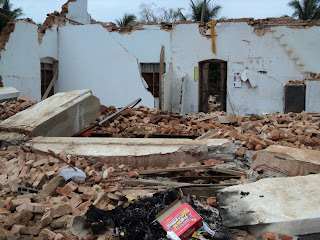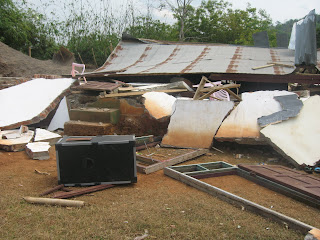More than 3,000 people have been made homeless in Shan State following the 7.0-magnitude earthquake that rocked the region on March 24, according to the latest joint report by aid agencies working in 90 affected villages.
Released on Wednesday by the UN's Office for the Coordination of Humanitarian Affairs (OCHA) in collaboration with several partners, the report said the most common illnesses reported are diarrhea and colds.
Among the 96 cases of diarrhea reported by World Vision on Tuesday, 48 have been confirmed by local health authorities but none are severe, according to the report.
The Myanmar Red Cross Society reported on Wednesday that 3,152 people in the region were made homeless by the earthquake.
Chris Herink, a World Vision spokesperson in Shan State, told The Irrawaddy that what is most urgently needed is safe drinking water. He said relief workers are continuing to distribute water purification tablets in the affected areas.
Initial findings of a rapid collaborated assessment indicate that at least 18,000 people residing in 90 villages have been affected by the earthquake. Most of those villages are located in Tarlay and Mong Lin townships. At least 150 people have been killed, according to local sources.
Local residents said that some of the affected areas are often inaccessible due to rains, and that there is an increased risk of landslides as the rainy season is due to start in a few weeks.
With regard to safe water, a main concern is the damaged gravity flow system in Tarlay, which supports the population in and around the town. However, further assessment on the extent of damages is still required, the report said, adding that the Tarlay authorities have estimated that 702 houses have been damaged.
According to the agencies' report, homeless villagers from Tarlay sub-township and Mong Lin (East) and Mong Lin (West) Village Tracts are in dire need of additional material support, particularly in terms of non-food items, such as tarpaulins, blankets and household utensils.
The agencies said that foodstuffs such as salt, cooking oil, noodles, dried fish, and cans of fish are being delivered. Tents, blankets, cooking utensils, plastic mats, mosquito nets, candles, water tanks, bottled water and water purification tablets are also being distributed by the humanitarian aid groups.
Many private donors have also been involved in distributing rice, instant noodles, cans of fish and beef, as well as fresh vegetables to those affected.
Some local residents said they found individual donations more effective than the government-channeled distribution of aid. They also claimed that government-monitored aid distributions have been delayed, and that supplies have been stolen.
Ca Mu, a Lahu resident in Yanshin village near Tachilek Township, said that local authorities such as the headmen of the villages and various paramilitaries control the aid, but don’t deliver it. “If they were really committed to the people, they would give us a helping hand,” he said.
“In my opinion, it doesn't matter whether the soldiers reach the affected villages or not, because even if they go there they do nothing significant for the people who need help,” he said. “In fact, it would be better if they didn't go at all—they make things worse.”
World Vision said it had identified a need to establish two warehouses in Tachilek and Tarlay to facilitate the ongoing relief and rehabilitation response. The World Food Program is also assessing the storage capacity in the areas, said the aid agencies’ statement.
From Irrawaddy News
Released on Wednesday by the UN's Office for the Coordination of Humanitarian Affairs (OCHA) in collaboration with several partners, the report said the most common illnesses reported are diarrhea and colds.
Among the 96 cases of diarrhea reported by World Vision on Tuesday, 48 have been confirmed by local health authorities but none are severe, according to the report.
The Myanmar Red Cross Society reported on Wednesday that 3,152 people in the region were made homeless by the earthquake.
Chris Herink, a World Vision spokesperson in Shan State, told The Irrawaddy that what is most urgently needed is safe drinking water. He said relief workers are continuing to distribute water purification tablets in the affected areas.
Initial findings of a rapid collaborated assessment indicate that at least 18,000 people residing in 90 villages have been affected by the earthquake. Most of those villages are located in Tarlay and Mong Lin townships. At least 150 people have been killed, according to local sources.
Local residents said that some of the affected areas are often inaccessible due to rains, and that there is an increased risk of landslides as the rainy season is due to start in a few weeks.
With regard to safe water, a main concern is the damaged gravity flow system in Tarlay, which supports the population in and around the town. However, further assessment on the extent of damages is still required, the report said, adding that the Tarlay authorities have estimated that 702 houses have been damaged.
According to the agencies' report, homeless villagers from Tarlay sub-township and Mong Lin (East) and Mong Lin (West) Village Tracts are in dire need of additional material support, particularly in terms of non-food items, such as tarpaulins, blankets and household utensils.
The agencies said that foodstuffs such as salt, cooking oil, noodles, dried fish, and cans of fish are being delivered. Tents, blankets, cooking utensils, plastic mats, mosquito nets, candles, water tanks, bottled water and water purification tablets are also being distributed by the humanitarian aid groups.
Many private donors have also been involved in distributing rice, instant noodles, cans of fish and beef, as well as fresh vegetables to those affected.
Some local residents said they found individual donations more effective than the government-channeled distribution of aid. They also claimed that government-monitored aid distributions have been delayed, and that supplies have been stolen.
Ca Mu, a Lahu resident in Yanshin village near Tachilek Township, said that local authorities such as the headmen of the villages and various paramilitaries control the aid, but don’t deliver it. “If they were really committed to the people, they would give us a helping hand,” he said.
“In my opinion, it doesn't matter whether the soldiers reach the affected villages or not, because even if they go there they do nothing significant for the people who need help,” he said. “In fact, it would be better if they didn't go at all—they make things worse.”
World Vision said it had identified a need to establish two warehouses in Tachilek and Tarlay to facilitate the ongoing relief and rehabilitation response. The World Food Program is also assessing the storage capacity in the areas, said the aid agencies’ statement.
From Irrawaddy News



No comments:
Post a Comment